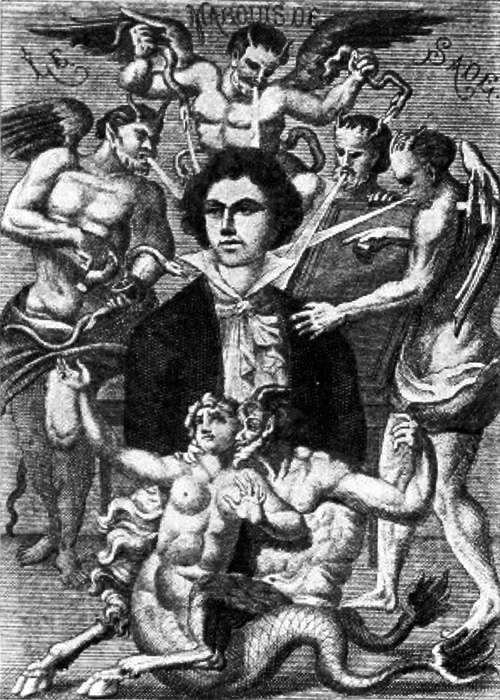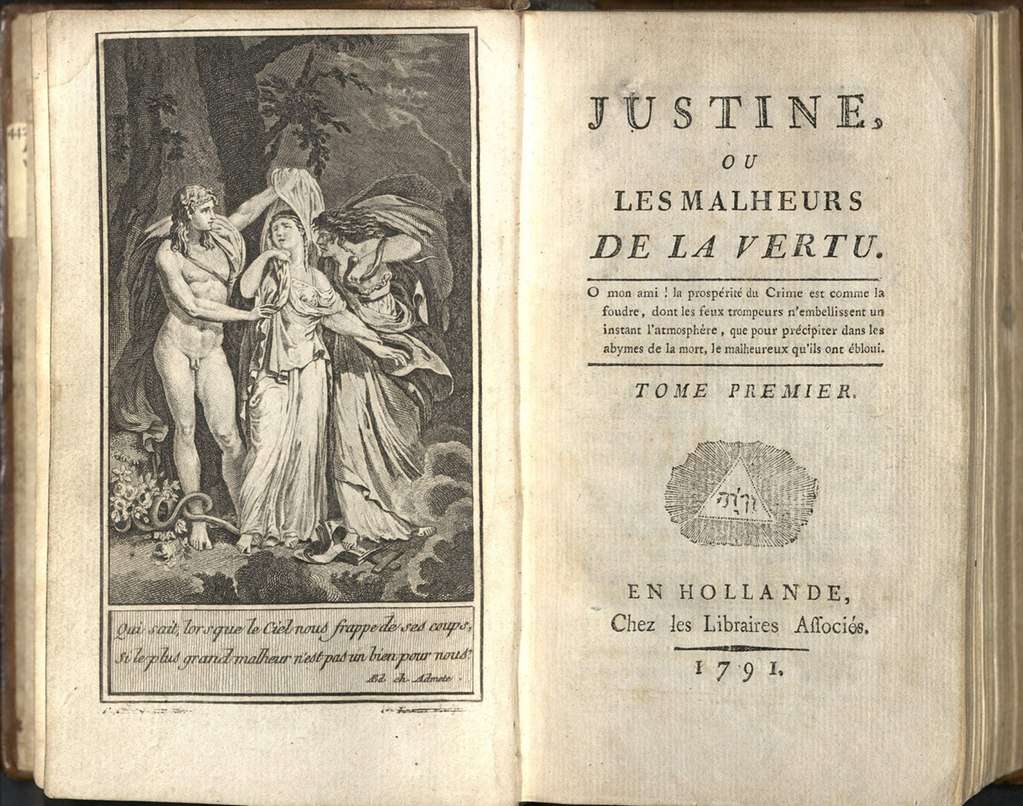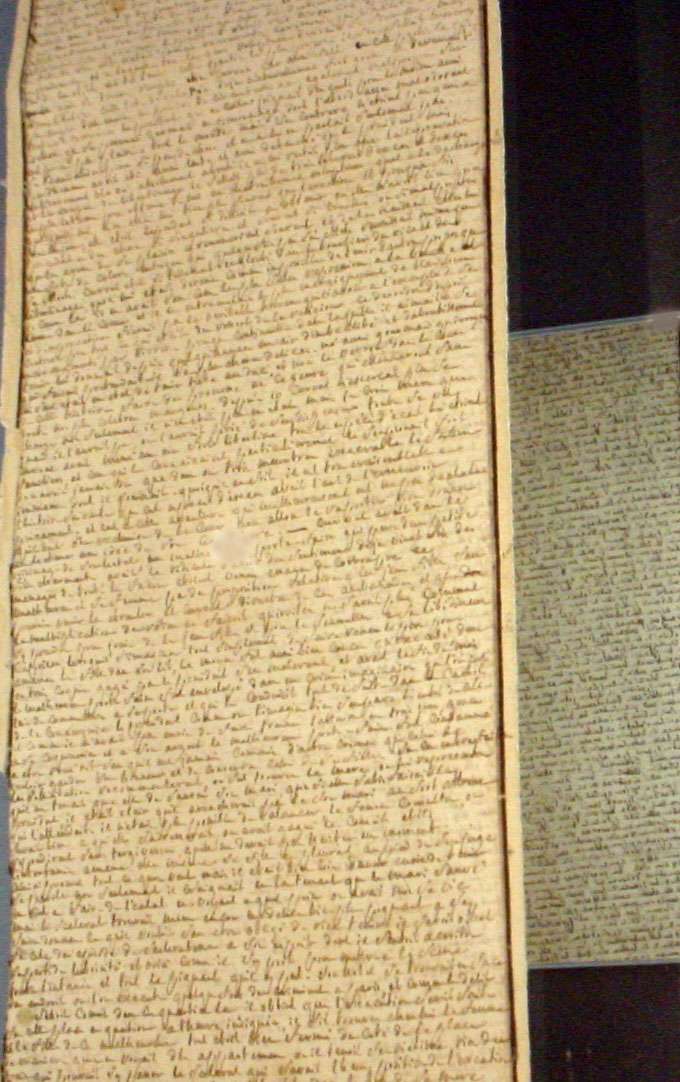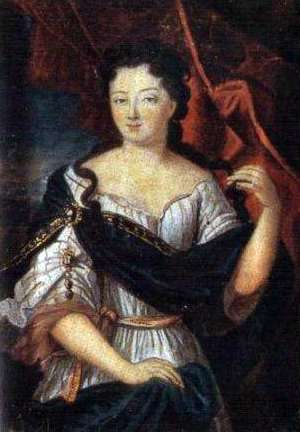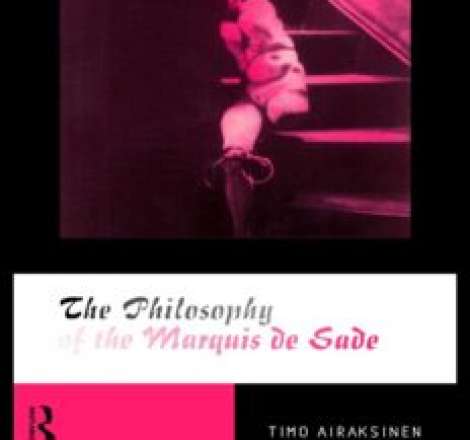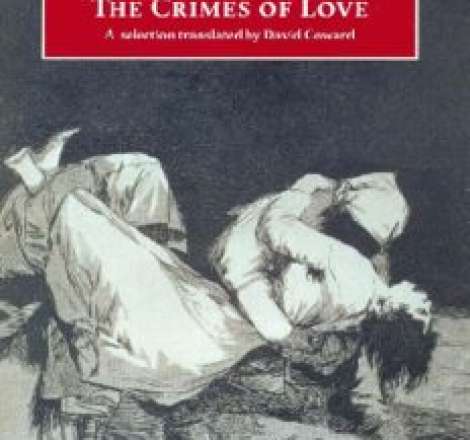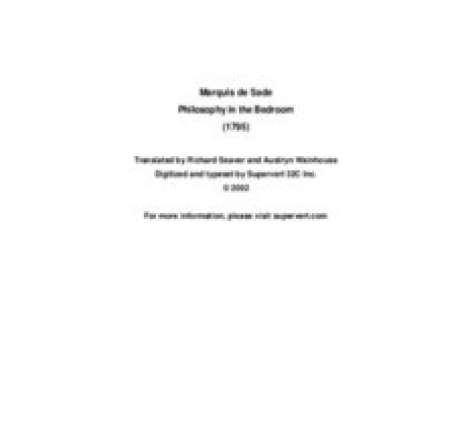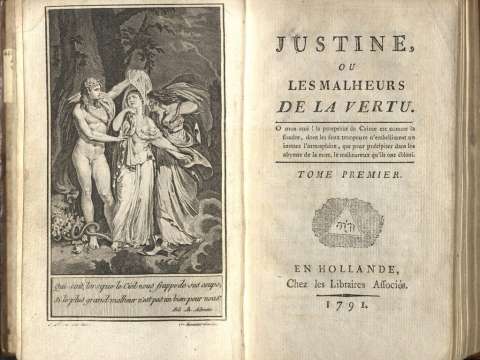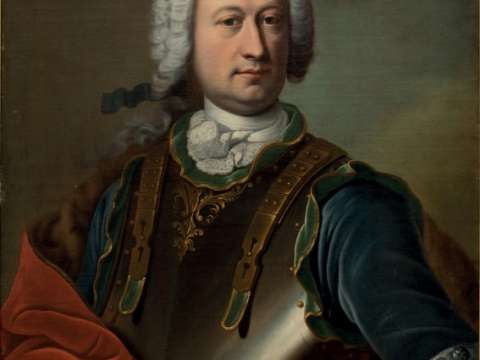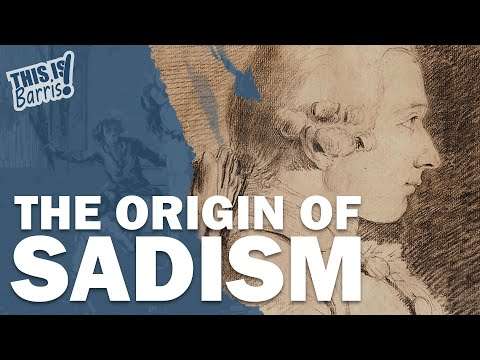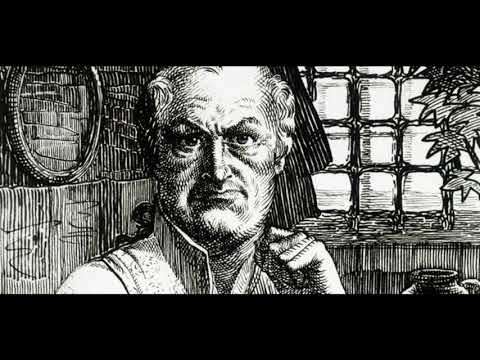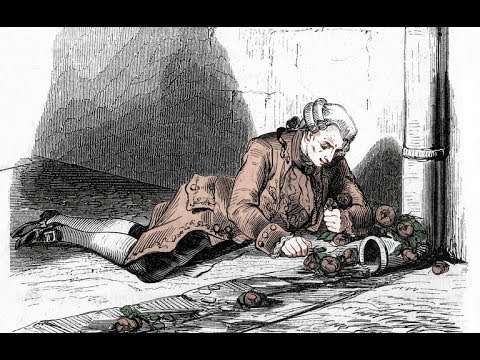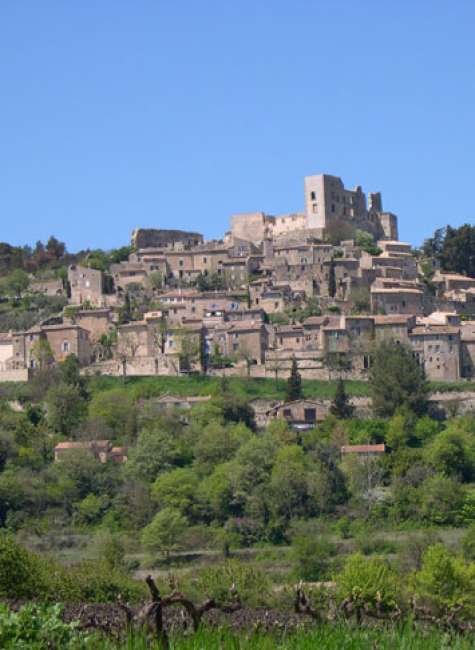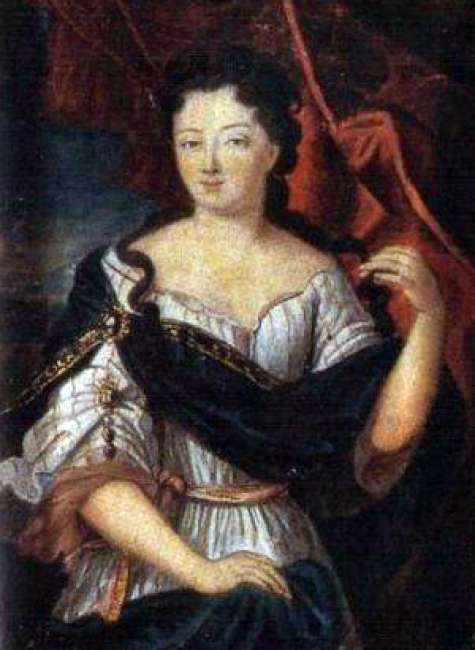

Marquis de Sade (1740-1814)
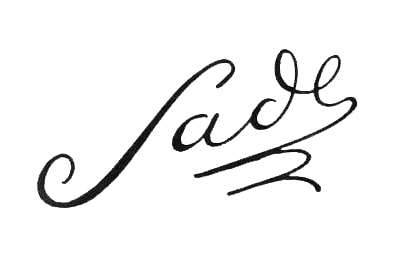
Either kill me or take me as I am, because I'll be damned if I ever change.
Donatien Alphonse François, Marquis de Sade was a French nobleman, revolutionary politician, philosopher, and writer, famous for his libertine sexuality. His works include novels, short stories, plays, dialogues, and political tracts. In his lifetime some of these were published under his own name while others, which de Sade denied having written, appeared anonymously. De Sade is best known for his erotic works, which combined philosophical discourse with pornography, depicting sexual fantasies with an emphasis on violence particularly against women and children, suffering, anal sex which he calls sodomy, crime, and blasphemy against Christianity. He became infamous for his numerous sexual crimes and abuse against young men, women, and children. He claimed to be a proponent of absolute freedom, unrestrained by morality, religion, or law. The words sadism and sadist are derived from his name.
De Sade was incarcerated in various prisons and an insane asylum for about 32 years of his life: 11 years in Paris 10 of which were spent in the Bastille, a month in the Conciergerie, two years in a fortress, a year in Madelonnettes Convent, three years in Bicêtre Asylum, a year in Sainte-Pélagie Prison, and 12 years in the Charenton Asylum. During the French Revolution, he was an elected delegate to the National Convention. Many of his works were written in prison.
There continues to be a fascination with de Sade among scholars and in popular culture. Prolific French intellectuals such as Roland Barthes, Jacques Lacan, Jacques Derrida, and Michel Foucault published studies of him. On the other hand, the French hedonist philosopher Michel Onfray has attacked this interest in de Sade, writing that "It is intellectually bizarre to make Sade a hero." There have also been numerous film adaptions of his work, the most notable being Pasolini's Salò, an adaptation of de Sade's infamous book, The 120 Days of Sodom.
Life
Early life and education
De Sade was born on 2 June 1740, in the Hôtel de Condé, Paris, to Jean Baptiste François Joseph, Count de Sade and Marie Eléonore de Maillé de Carman, distant cousin and Lady-in-waiting to the Princess of Condé. He was his parents' only surviving child. He was educated by an uncle, the Abbé de Sade. In Sade's youth, his father abandoned the family; his mother joined a convent. He was raised by servants who indulged "his every whim," which led to his becoming "known as a rebellious and spoiled child with an ever-growing temper."

Later in his childhood, Sade was sent to the Lycée Louis-le-Grand in Paris, a Jesuit college, for four years. While at the school, he was tutored by Abbé Jacques-François Amblet, a priest. Later in life, at one of Sade's trials the Abbé testified, saying that Sade had a "passionate temperament which made him eager in the pursuit of pleasure" but had a "good heart." At the Lycée Louis-le-Grand, he was subjected to "severe corporal punishment," including "flagellation," and he "spent the rest of his adult life obsessed with the violent act."
At age 14, Sade began attending an elite military academy. After twenty months of training, on 14 December 1755, at age 15, Sade was commissioned as a sub-lieutenant, becoming a soldier. After thirteen months as a sub-lieutenant, he was commissioned to the rank of cornet in the Brigade de S. André of the Comte de Provence's Carbine Regiment. He eventually became Colonel of a Dragoon regiment and fought in the Seven Years' War. In 1763, on returning from war, he courted a rich magistrate's daughter, but her father rejected his suitorship and instead arranged a marriage with his elder daughter, Renée-Pélagie de Montreuil; that marriage produced two sons and a daughter. In 1766, he had a private theatre built in his castle, the Château de Lacoste, in Provence. In January 1767, his father died.
Title and heirs
The men of the Sade family alternated between using the marquis and comte count titles. His grandfather, Gaspard François de Sade, was the first to use marquis; occasionally, he was the Marquis de Sade, but is identified in documents as the Marquis de Mazan. The Sade family were noblesse d'épée, claiming at the time the oldest, Frank-descended nobility, so assuming a noble title without a King's grant, was customarily de rigueur. Alternating title usage indicates that titular hierarchy below duc et pair was notional; theoretically, the marquis title was granted to noblemen owning several countships, but its use by men of dubious lineage caused its disrepute. At Court, precedence was by seniority and royal favor, not title. There is father-and-son correspondence, wherein father addresses son as marquis.

For many years, Sade's descendants regarded his life and work as a scandal to be suppressed. This did not change until the mid-twentieth century, when the Comte Xavier de Sade reclaimed the marquis title, long fallen into disuse, on his visiting cards, and took an interest in his ancestor's writings. At that time, the "divine marquis" of legend was so unmentionable in his own family that Xavier de Sade only learned of him in the late 1940s when approached by a journalist. He subsequently discovered a store of Sade's papers in the family château at Condé-en-Brie, and worked with scholars for decades to enable their publication. His youngest son, the Marquis Thibault de Sade, has continued the collaboration. The family have also claimed a trademark on the name. The family sold the Château de Condé in 1983. As well as the manuscripts they retain, others are held in universities and libraries. Many, however, were lost in the eighteenth and nineteenth centuries. A substantial number were destroyed after Sade's death at the instigation of his son, Donatien-Claude-Armand.
Scandals and imprisonment
Sade lived a scandalous libertine existence and repeatedly procured young prostitutes as well as employees of both sexes in his castle in Lacoste. He was also accused of blasphemy, which was considered a serious offense. His behavior also included an affair with his wife's sister, Anne-Prospère, who had come to live at the castle.
Beginning in 1763, Sade lived mainly in or near Paris. Several prostitutes there complained about mistreatment by him and he was put under surveillance by the police, who made detailed reports of his activities. After several short imprisonments, which included a brief incarceration in the Château de Saumur then a prison, he was exiled to his château at Lacoste in 1768.
The first major scandal occurred on Easter Sunday in 1768, in which Sade procured the services of a woman, Rose Keller, a widow-beggar who approached him for alms. He told her she could make money by working for him—she understood her work to be that of a housekeeper. At his chateau at Arcueil, Sade ripped her clothes off, threw her on a divan and tied her by the four limbs, face-down, so that she could not see behind her. Then he whipped her. Keller testified that he made various incisions on her body into which he poured hot wax, although investigators found no broken skin on Keller, and Sade explained that he had applied ointment to her after the whipping. Keller finally escaped by climbing out of a second-floor window and running away. The Sade family paid the maid to keep her quiet, but the wave of social embarrassment damaged Sade's reputation. La Présidente, Sade's mother-in-law, obtained a lettre de cachet a royal order of arrest and imprisonment, without stated cause or access to the courts from the King, protecting Sade from the jurisdiction of the courts. The lettre de cachet would later prove disastrous for the marquis.

Four years later, in 1772, Sade committed further acts with four prostitutes and his manservant, Latour. This episode in Marseille involved the drugging of prostitutes with the supposed aphrodisiac Spanish fly and sodomy with Latour. The two men were sentenced to death in absentia for sodomy and the poisoning. They fled to Italy, Sade taking his wife's sister with him. Sade and Latour were caught and imprisoned at the Fortress of Miolans in French Savoy in late 1772, but escaped four months later.
Sade later hid at Lacoste where he rejoined his wife, who became an accomplice in his subsequent endeavors. In 1774, Sade trapped six children, including one boy, in his chateau for six weeks during which time he subjected them to abuse, which his wife allowed. He kept a group of young employees at the chateau, most of whom complained about molestation and quickly left his service. Sade was forced to flee to Italy once again. It was during this time he wrote Voyage d'Italie. In 1776, he returned to Lacoste, again hired several servant girls, most of whom soon fled. In 1777, the father of one of those employees went to Lacoste to claim his daughter, and attempted to shoot the Marquis at point-blank range, but the gun misfired.
Later that year, Sade was tricked into going to Paris to visit his supposedly ill mother, who in fact had recently died. He was arrested and imprisoned in the Château de Vincennes. He successfully appealed his death sentence in 1778 but remained imprisoned under the lettre de cachet. He escaped but was soon recaptured. He resumed writing and met fellow prisoner Comte de Mirabeau, who also wrote erotic works. Despite this common interest, the two came to dislike each other intensely.
In 1784, Vincennes was closed, and Sade was transferred to the Bastille. The following year, he wrote the manuscript for his magnum opus Les 120 Journées de Sodome The 120 Days of Sodom, which he wrote in minuscule handwriting on a continuous roll of paper he rolled tightly and placed in his cell wall to hide. He was unable to finish the work; on 4 July 1789, he was transferred "naked as a worm" to the insane asylum at Charenton near Paris, two days after he reportedly incited unrest outside the prison by shouting to the crowds gathered there, "They are killing the prisoners here!" Sade was unable to retrieve the manuscript before being removed from the prison. The storming of the Bastille, a major event of the French Revolution, occurred ten days after Sade left, on 14 July. To his despair, he believed that the manuscript was destroyed in the storming of the Bastille, though it was actually saved by a man named Arnoux de Saint-Maximin two days before the Bastille was attacked. It is not known why Saint-Maximin chose to bring the manuscript to safety, nor indeed is anything else about him known. In 1790, Sade was released from Charenton after the new National Constituent Assembly abolished the instrument of lettre de cachet. His wife obtained a divorce soon afterwards.
Return to freedom, delegate to the National Convention, and imprisonment
During Sade's time of freedom, beginning in 1790, he published several of his books anonymously. He met Marie-Constance Quesnet, a former actress with a six-year-old son, who had been abandoned by her husband. Constance and Sade stayed together for the rest of his life.
He initially adapted the new political order after the revolution, supported the Republic, called himself "Citizen Sade", and managed to obtain several official positions despite his aristocratic background.
Because of the damage done to his estate in Lacoste, which was sacked in 1789 by an angry mob, he moved to Paris. In 1790, he was elected to the National Convention, where he represented the far left. He was a member of the Piques section, notorious for its radical views. He wrote several political pamphlets, in which he called for the implementation of direct vote. However, there is much evidence suggesting that he suffered abuse from his fellow revolutionaries due to his aristocratic background. Matters were not helped by his son's May 1792 desertion from the military, where he had been serving as a second lieutenant and the aide-de-camp to an important colonel, the Marquis de Toulengeon. Sade was forced to disavow his son's desertion in order to save himself. Later that year, his name was added—whether by error or wilful malice—to the list of émigrés of the Bouches-du-Rhône department.
While claiming he was opposed to the Reign of Terror in 1793, he wrote an admiring eulogy for Jean-Paul Marat. At this stage, he was becoming publicly critical of Maximilien Robespierre and, on 5 December, he was removed from his posts, accused of moderatism, and imprisoned for almost a year. He was released in 1794 after the end of the Reign of Terror.
In 1796, now completely destitute, he had to sell his ruined castle in Lacoste.
Imprisonment for his writings and death
In 1801, Napoleon Bonaparte ordered the arrest of the anonymous author of Justine and Juliette. Sade was arrested at his publisher's office and imprisoned without trial; first in the Sainte-Pélagie Prison and, following allegations that he had tried to seduce young fellow prisoners there, in the harsh Bicêtre Asylum.
After intervention by his family, he was declared insane in 1803 and transferred once more to the Charenton Asylum. His ex-wife and children had agreed to pay his pension there. Constance, pretending to be his relative, was allowed to live with him at Charenton. The director of the institution, Abbé de Coulmier, allowed and encouraged him to stage several of his plays, with the inmates as actors, to be viewed by the Parisian public. Coulmier's novel approaches to psychotherapy attracted much opposition. In 1809, new police orders put Sade into solitary confinement and deprived him of pens and paper. In 1813, the government ordered Coulmier to suspend all theatrical performances.

Sade began a sexual relationship with 14-year-old Madeleine LeClerc, daughter of an employee at Charenton. This lasted some four years, until his death in 1814.
He had left instructions in his will forbidding that his body be opened for any reason whatsoever, and that it remain untouched for 48 hours in the chamber in which he died, and then placed in a coffin and buried on his property located in Malmaison near Épernon. These instructions were not followed; he was buried at Charenton. His skull was later removed from the grave for phrenological examination. His son had all his remaining unpublished manuscripts burned, including the immense multi-volume work Les Journées de Florbelle.
Appraisal and criticism
Numerous writers and artists, especially those concerned with sexuality, have been both repelled and fascinated by Sade. He has garnered the title of rapist and pedophile, and critics have debated whether his work has any redeeming value. An article in The Independent, a British online newspaper, gives contrasting views: the French novelist Pierre Guyotat said, "Sade is, in a way, our Shakespeare. He has the same sense of tragedy, the same sweeping grandeur" while anarchist philosopher Michel Onfray said, "it is intellectually bizarre to make Sade a hero... Even according to his most hero-worshipping biographers, this man was a sexual delinquent".
The contemporary rival pornographer Rétif de la Bretonne published an Anti-Justine in 1798.
Geoffrey Gorer, an English anthropologist and author 1905–1985, wrote one of the earliest books on Sade, entitled The Revolutionary Ideas of the Marquis de Sade in 1935. He pointed out that Sade was in complete opposition to contemporary philosophers for both his "complete and continual denial of the right to property" and for viewing the struggle in late 18th century French society as being not between "the Crown, the bourgeoisie, the aristocracy or the clergy, or sectional interests of any of these against one another", but rather all of these "more or less united against the proletariat." By holding these views, he cut himself off entirely from the revolutionary thinkers of his time to join those of the mid-nineteenth century. Thus, Gorer argued, "he can with some justice be called the first reasoned socialist."
Simone de Beauvoir in her essay Must we burn Sade?, published in Les Temps modernes, December 1951 and January 1952 and other writers have attempted to locate traces of a radical philosophy of freedom in Sade's writings, preceding modern existentialism by some 150 years. He has also been seen as a precursor of Sigmund Freud's psychoanalysis in his focus on sexuality as a motive force. The surrealists admired him as one of their forerunners, and Guillaume Apollinaire famously called him "the freest spirit that has yet existed".
Pierre Klossowski, in his 1947 book Sade Mon Prochain "Sade My Neighbour", analyzes Sade's philosophy as a precursor of nihilism, negating Christian values and the materialism of the Enlightenment.
One of the essays in Max Horkheimer and Theodor Adorno's Dialectic of Enlightenment 1947 is titled "Juliette, or Enlightenment and Morality" and interprets the ruthless and calculating behavior of Juliette as the embodiment of the philosophy of enlightenment. Similarly, psychoanalyst Jacques Lacan posited in his 1963 essay Kant avec Sade that Sade's ethics was the complementary completion of the categorical imperative originally formulated by Immanuel Kant. However, at least one philosopher has rejected Adorno and Horkheimer's claim that Sade's moral skepticism is actually coherent, or that it reflects Enlightenment thought, and concludes it fits better into the emerging Counter-Enlightenment of the time. A similarity to the later philosophy of Max Stirner and Friedrich Nietzsche along with Nazi ideology has also been claimed, although it is admitted that no evidence exists for the Nazis being directly inspired by De Sade Nietzsche however didn't read him.
In his 1988 Political Theory and Modernity, William E. Connolly analyzes Sade's Philosophy in the Bedroom as an argument against earlier political philosophers, notably Jean-Jacques Rousseau and Thomas Hobbes, and their attempts to reconcile nature, reason, and virtue as bases of ordered society. Similarly, Camille Paglia argued that Sade can be best understood as a satirist, responding "point by point" to Rousseau's claims that society inhibits and corrupts mankind's innate goodness: Paglia notes that Sade wrote in the aftermath of the French Revolution, when Rousseauist Jacobins instituted the bloody Reign of Terror and Rousseau's predictions were brutally disproved. "Simply follow nature, Rousseau declares. Sade, laughing grimly, agrees."
In The Sadeian Woman: And the Ideology of Pornography 1979, Angela Carter provides a feminist reading of Sade, seeing him as a "moral pornographer" who creates spaces for women. Similarly, Susan Sontag defended both Sade and Georges Bataille's Histoire de l'œil Story of the Eye in her essay "The Pornographic Imagination" 1967 on the basis their works were transgressive texts, and argued that neither should be censored. By contrast, Andrea Dworkin saw Sade as the exemplary woman-hating pornographer, supporting her theory that pornography inevitably leads to violence against women. One chapter of her book Pornography: Men Possessing Women 1979 is devoted to an analysis of Sade. Susie Bright claims that Dworkin's first novel Ice and Fire, which is rife with violence and abuse, can be seen as a modern retelling of Sade's Juliette.
In his doctoral thesis G. T. Roche, a New Zealand philosopher, argued that Sade, contrary to what some have claimed, did indeed express a specific philosophical worldview. He identifies a number of positions Sade had argued for, including antitheism, atheism, determinism, hedonism, materialism, moral relativism, moral nihilism and proto-Social Darwinism. He also criticizes Sade's views, seeing in the last along with blaming the Jews for creating the "weak" religion Christianity a precursor to Adolf Hitler's philosophy though also not claiming a direct link, i.e. that Hitler in fact read Sade. However, he has also said Sade's views cannot be blamed on Enlightenment philosophy nor inspired the Holocaust, contra Theodor Adorno and Max Horkheimer in their work Dialectic of Enlightenment rather, he associates both of them with the emerging Counter-Enlightenment, seeing similarities here to Friedrich Nietzsche's philosophy too, while also elucidating differences Sade had from Nazis' views. Additionally, he criticizes the idea Sade demonstrated morality cannot be based on reason.
Influence
Sexual sadism disorder, a mental condition named after Sade, has been defined as experiencing sexual arousal in response to extreme pain, suffering or humiliation done non-consensually to others as described in Sade's novels. Other terms have been used to describe the condition, which may overlap with other sexual preferences that also involve inflicting pain. It is distinct from situations where consenting individuals use mild or simulated pain or humiliation for sexual excitement.
Various influential cultural figures have expressed a great interest in Sade's work, including the French philosopher Michel Foucault, the American film maker John Waters and the Spanish filmmaker Jesús Franco. The poet Algernon Charles Swinburne is also said to have been highly influenced by Sade. Nikos Nikolaidis' 1979 film The Wretches Are Still Singing was shot in a surreal way with a predilection for the aesthetics of the Marquis de Sade; Sade is said to have influenced Romantic and Decadent authors such as Charles Baudelaire, Gustave Flaubert, and Rachilde; and to have influenced a growing popularity of nihilism in Western thought. Sade's notions on strength and weakness and good and evil, such as the "equilibrium" of good and evil in the world required by Nature which the monk Clément mentions in Justine, may have also been a considerable influence on Friedrich Nietzsche, particularly concerning the views on good and evil in Nietzsche's On the Genealogy of Morality 1887. The philosopher of egoist anarchism, Max Stirner, is also speculated to have been influenced by Sade's work.
Serial killer Ian Brady, who with Myra Hindley carried out torture and murder of children known as the Moors murders in England during the 1960s, was fascinated by Sade, and the suggestion was made at their trial and appeals that the tortures of the children the screams and pleadings of whom they tape-recorded were influenced by Sade's ideas and fantasies. According to Donald Thomas, who has written a biography on Sade, Brady and Hindley had read very little of Sade's actual work; the only book of his they possessed was an anthology of excerpts that included none of his most extreme writings. In the two suitcases found by the police that contained books that belonged to Brady was The Life and Ideas of the Marquis de Sade. Hindley herself claimed that Brady would send her to obtain books by Sade, and that after reading them he became sexually aroused and beat her.
In Philosophy in the Bedroom Sade proposed the use of induced abortion for social reasons and population control, marking the first time the subject had been discussed in public. It has been suggested that Sade's writing influenced the subsequent medical and social acceptance of abortion in Western society.
Cultural depictions
There have been many and varied references to the Marquis de Sade in popular culture, including fictional works and biographies. The eponym of the psychological and subcultural term sadism, his name is used variously to evoke sexual violence, licentiousness, and freedom of speech. In modern culture his works are simultaneously viewed as masterful analyses of how power and economics work, and as erotica. On a conventional moral view in Sade's time as today, Sade was incarcerated because his predilection for sexual and corporal abuse of vulnerable individuals made him a serious danger to the public. On the other hand, it could be argued that Sade's sexually explicit works were a medium for the articulation but also for the exposure of the corrupt and hypocritical values of the elite in his society, and that it was primarily this inconvenient and embarrassing satire that led to his long-term detention. On the second view he becomes a symbol of the artist's struggle with the censor and that of the moral philosopher with the constraints of conventional morality. Sade's use of pornographic devices to create provocative works that subvert the prevailing moral values of his time inspired many other artists in a variety of media. The cruelties depicted in his works gave rise to the concept of sadism. Sade's works have to this day been kept alive by certain artists and intellectuals because they themselves espouse a philosophy of extreme individualism. But Sade's life was lived in flat contradiction and breach of Kant's injunction to treat others as ends in themselves and never merely as means to an agent's own ends.
In the late 20th century, there was a resurgence of interest in Sade; leading French intellectuals like Roland Barthes, Jacques Lacan, Jacques Derrida, and Michel Foucault published studies of the philosopher, and interest in Sade among scholars and artists continued. In the realm of visual arts, many surrealist artists had interest in the "Divine Marquis." Sade was celebrated in surrealist periodicals, and feted by figures such as Guillaume Apollinaire, Paul Éluard, and Maurice Heine; Man Ray admired Sade because he and other surrealists viewed him as an ideal of freedom. The first Manifesto of Surrealism 1924 announced that "Sade is surrealist in sadism", and extracts of the original draft of Justine were published in Le Surréalisme au service de la révolution. In literature, Sade is referenced in several stories by horror and science fiction writer and author of Psycho Robert Bloch, while Polish science fiction author Stanisław Lem wrote an essay analyzing the game theory arguments appearing in Sade's Justine. The writer Georges Bataille applied Sade's methods of writing about sexual transgression to shock and provoke readers.

Sade's life and works have been the subject of numerous fictional plays, films, pornographic or erotic drawings, etchings, and more. These include Peter Weiss's play Marat/Sade, a fantasia extrapolating from the fact that Sade directed plays performed by his fellow inmates at the Charenton asylum. Yukio Mishima, Barry Yzereef, and Doug Wright also wrote plays about Sade; Weiss's and Wright's plays have been made into films. His work is referenced on film at least as early as Luis Buñuel's L'Âge d'Or 1930, the final segment of which provides a coda to 120 Days of Sodom, with the four debauched noblemen emerging from their mountain retreat. In 1969, American International Films released a German-made production called de Sade, with Keir Dullea in the title role. Pier Paolo Pasolini filmed Salò, or the 120 Days of Sodom 1975, updating Sade's novel to the brief Salò Republic; Benoît Jacquot's Sade and Philip Kaufman's Quills from the play of the same name by Doug Wright both hit cinemas in 2000. Quills, inspired by Sade's imprisonment and battles with the censorship in his society, portrays him Geoffrey Rush as a literary freedom fighter who is a martyr to the cause of free expression. Sade is a 2000 French film directed by Benoît Jacquot starring Daniel Auteuil as the Marquis de Sade, which was adapted by Jacques Fieschi and Bernard Minoret from the novel La terreur dans le boudoir by Serge Bramly.
Often Sade himself has been depicted in American popular culture less as a revolutionary or even as a libertine and more akin to a sadistic, tyrannical villain. For example, in the final episode of the television series Friday the 13th: The Series, Micki, the female protagonist, travels back in time and ends up being imprisoned and tortured by Sade. Similarly, in the horror film Waxwork, Sade is among the film's wax villains to come alive.
While not personally depicted, Sade's writings feature prominently in the novel Too Like the Lightning, first book in the Terra Ignota sequence written by Ada Palmer. Palmer's depiction of 25th century Earth relies heavily on the philosophies and prominent figureheads of the Enlightenment, such as Voltaire and Denis Diderot in addition to Sade, and in the book the narrator Mycroft, after showing his fictional "reader" a sex scene formulated off of Sade's own, takes this imaginary reader's indignation as an opportunity to delve into Sade's ideas. Additionally, one of the central locations in the novel, a brothel advertising itself as a "bubble of the 18th century", features an inscription over the proprietor's door dedicating the establishment as a temple to Sade, an homage to Voltaire's "Le Temple du goût, par M. de Voltaire."
Writing
Literary criticism
The Marquis de Sade viewed Gothic fiction as a genre that relied heavily on magic and phantasmagoria. In his literary criticism Sade sought to prevent his fiction from being labeled "Gothic" by emphasizing Gothic's supernatural aspects as the fundamental difference from themes in his own work. But while he sought this separation he believed the Gothic played a necessary role in society and discussed its roots and its uses. He wrote that the Gothic novel was a perfectly natural, predictable consequence of the revolutionary sentiments in Europe. He theorized that the adversity of the period had rightfully caused Gothic writers to "look to hell for help in composing their alluring novels." Sade held the work of writers Matthew Lewis and Ann Radcliffe high above other Gothic authors, praising the brilliant imagination of Radcliffe and pointing to Lewis' The Monk as without question the genre's best achievement. Sade nevertheless believed that the genre was at odds with itself, arguing that the supernatural elements within Gothic fiction created an inescapable dilemma for both its author and its readers. He argued that an author in this genre was forced to choose between elaborate explanations of the supernatural or no explanation at all and that in either case the reader was unavoidably rendered incredulous. Despite his celebration of The Monk, Sade believed that there was not a single Gothic novel that had been able to overcome these problems, and that a Gothic novel that did would be universally regarded for its excellence in fiction.
Many assume that Sade's criticism of the Gothic novel is a reflection of his frustration with sweeping interpretations of works like Justine. Within his objections to the lack of verisimilitude in the Gothic may have been an attempt to present his own work as the better representation of the whole nature of man. Since Sade professed that the ultimate goal of an author should be to deliver an accurate portrayal of man, it is believed that Sade's attempts to separate himself from the Gothic novel highlights this conviction. For Sade, his work was best suited for the accomplishment of this goal in part because he was not chained down by the supernatural silliness that dominated late 18th-century fiction. Moreover, it is believed that Sade praised The Monk which displays Ambrosio's sacrifice of his humanity to his unrelenting sexual appetite as the best Gothic novel chiefly because its themes were the closest to those within his own work.
Libertine novels
Sade's fiction has been classified under different genres, including pornography, Gothic, and baroque. Sade's most famous books are often classified not as Gothic but as libertine novels, and include the novels Justine, or the Misfortunes of Virtue; Juliette; The 120 Days of Sodom; and Philosophy in the Bedroom. These works challenge traditional perceptions of sexuality, religion, law, age, and gender. His opinions on sexual violence, sadism, and pedophilia stunned even those contemporaries of Sade who were quite familiar with the dark themes of the Gothic novel during its popularity in the late 18th century. Suffering is the primary rule, as in these novels one must often decide between sympathizing with the torturer or the victim. While these works focus on the dark side of human nature, the magic and phantasmagoria that dominates the Gothic is noticeably absent and is the primary reason these works are not considered to fit the genre.
Through the unreleased passions of his libertines, Sade wished to shake the world at its core. With 120 Days, for example, Sade wished to present "the most impure tale that has ever been written since the world exists." Despite his literary attempts at evil, his characters and stories often fell into repetition of sexual acts and philosophical justifications. Simone de Beauvoir and Georges Bataille have argued that the repetitive form of his libertine novels, though hindering the artfulness of his prose, ultimately strengthened his individualist arguments. The repetitive and obsessive nature of the account of Justine's abuse and frustration in her strivings to be a good Christian living a virtuous and pure life may on a superficial reading seem tediously excessive. Paradoxically, however, Sade checks the reader's instinct to treat them as laughable cheap pornography and obscenity by knowingly and artfully interweaving the tale of her trials with extended reflections on individual and social morality.
Short fiction
In The Crimes of Love, subtitled "Heroic and Tragic Tales", Sade combines romance and horror, employing several Gothic tropes for dramatic purposes. There is blood, banditti, corpses, and of course insatiable lust. Compared to works like Justine, here Sade is relatively tame, as overt eroticism and torture is subtracted for a more psychological approach. It is the impact of sadism instead of acts of sadism itself that emerge in this work, unlike the aggressive and rapacious approach in his libertine works. The modern volume entitled Gothic Tales collects a variety of other short works of fiction intended to be included in Sade's Contes et Fabliaux d'un Troubadour Provencal du XVIII Siecle.
An example is "Eugénie de Franval", a tale of incest and retribution. In its portrayal of conventional moralities it is something of a departure from the erotic cruelties and moral ironies that dominate his libertine works. It opens with a domesticated approach:
Descriptions in Justine seem to anticipate Radcliffe's scenery in The Mysteries of Udolpho and the vaults in The Italian, but, unlike these stories, there is no escape for Sade's virtuous heroine, Justine. Unlike the milder Gothic fiction of Radcliffe, Sade's protagonist is brutalized throughout and dies tragically. To have a character like Justine, who is stripped without ceremony and bound to a wheel for fondling and thrashing, would be unthinkable in the domestic Gothic fiction written for the bourgeoisie. Sade even contrives a kind of affection between Justine and her tormentors, suggesting shades of masochism in his heroine.
Bibliography
More facts
Donatien Claude Armand de Sade (1769–1847)
Madeleine Laure de Sade (1771–1844)
Erotic Symphony (1980)
Justine and Juliette (1975)

